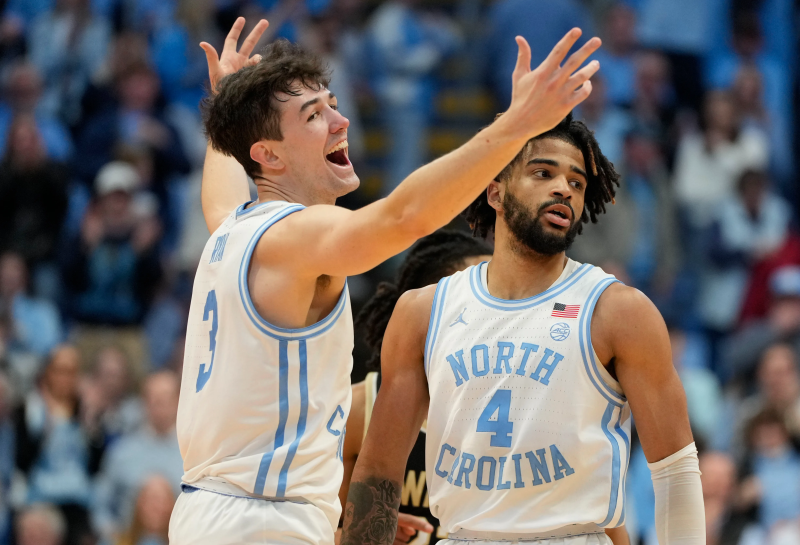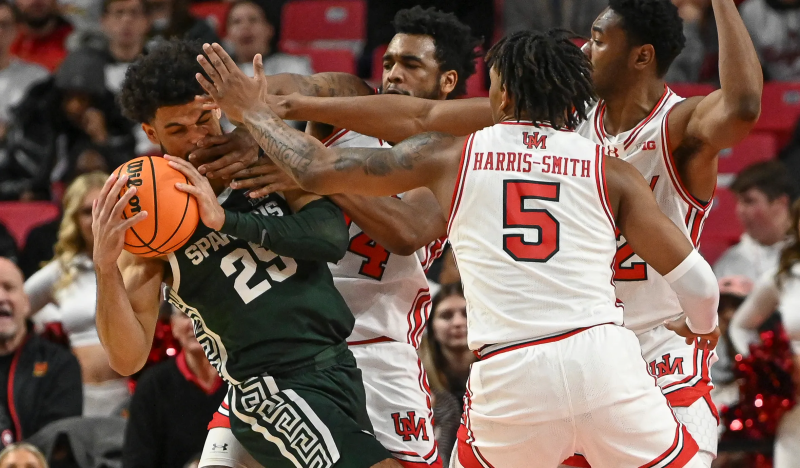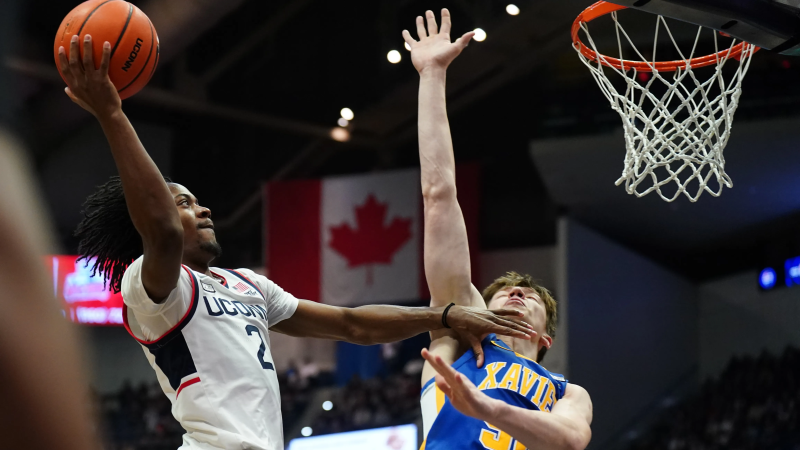What have you missed this season in men's college basketball? Here are eight key questions
With the college football season in the books and the NFL’s nearly so, casual fans will start turning their attention to hardwood matters in anticipation of the next big event on the sports calendar. So before March Madness actually arrives, those who haven’t been dialed into men's college basketball yet will want a quick catchup. This piece is for you, as well as for those who are followers of a particular school and have kept up with your team and conference but might need more info on what’s happening around the rest of the country.
To be clear, we recognize that there are many of you who live and breathe college basketball and have stayed in the know since the season tipped off in November. But if you are just starting to tune in, here’s what’s happened so far in men’s hoops.
Which teams are this year’s biggest surprises?
North Carolina: After missing last year's tournament, the Tar Heels have shown every indication they are ready to compete for championships again. The key holdovers, RJ Davis and Armando Bacot, have been joined by transfers Harrison Ingram and Cormac Ryan to create formidable lineup. Freshman point guard Elliot Cadeau has emerged as the facilitator the team had been missing.

Wisconsin: The Badgers began inauspiciously with no preseason ranking and a 1-2 start. Their Dec. 2 triumph against a then top-five Marquette squad might be seen as the breakthrough, and Wisconsin now finds itself atop the Big Ten standings with AJ Storr leading the way.
Texas Tech: Though the Big 12 race is less than half completed, you’d still likely not find many prognosticators who would have put the Red Raiders in first place by a game at this point. There’s a long way to go, of course, but the backcourt tandem of Pop Isaacs and Joe Toussaint usually get the ball to the right place.
Utah State: Danny Sprinkle is the school's third head coach in four years, yet somehow the Aggies keep finding ways to compete in the rugged Mountain West. It remains to be seen if they or any other representatives of the league can emulate San Diego State’s tournament success, but there’s no disputing the team’s ability to compete on a nightly basis.
Appalachian State: James Madison’s hot start got most of the attention in the Sun Belt, but it is the Mountaineers who top the league standings and show signs of being a tough out in March. Though they’ve yet to gain the attention of poll voters, they own a non-conference win against Auburn and just solidified their conference lead with a sweep of the Dukes.
Which teams have disappointed?
Michigan State: The Spartans returned most of their key parts from last year's Sweet 16 and were ranked No. 4 in the preseason poll. The season started poorly with a home loss to James Madison and hasn't gotten much better. Tom Izzo will probably get this team in the tournament but it won't go as far as anticipated without major improvement.

Gonzaga: The Bulldogs have been in the tournament every season since their run to the Elite Eight in 1999. Their inclusion is not a certainty this year as they lack a Quad 1 win and are looking up at Saint Mary's in the WCC. With Graham Ike and Ryan Nembhard there's still hope things turn around.
Miami (Fla.): Fresh off their Final Four showing last year, the Hurricanes were expected to be among the top contenders in the ACC. It hasn't worked out that way and they're fighting to just make the field this season.
Arkansas: Eric Musselman's typical formula of merging elite recruits with veterans has resulted in deep tournament runs in recent years. That doesn't seem likely this season with the Razorbacks at 10-10 with losses in six of their seven SEC games.
UCLA and Southern California: Both the Los Angeles teams were ranked in the preseason and are nowhere near the tournament bubble. It's humbling for both teams to have losing records and in the bottom half of the Pac-12.
Who are the candidates for national player of the year?
Zach Edey, Purdue: The 7-4 big man from Canada has picked up where he left off last year, dominating the paint for the Boilermakers to the tune of 23.0 points, 11.4 rebounds and 2.3 blocks a game.
RJ Davis, G, North Carolina: The Tar Heels’ veteran sharpshooter might already be a lock for ACC player of the year, putting up a league-best 21.2 points a game while connecting at a 40.8% clip from three-point range and 92.9% from the free-throw line.
Dalton Knecht, G, Tennessee: The transfer from Northern Colorado has given the Volunteers the consistent perimeter scoring threat that was missing from last year’s squad. He’s gone for 30-plus points in three of his last four outings.
Tyler Kolek, Marquette: The ignition switch for the Golden Eagles is the Big East’s top assist man at 7.1 a game while chipping in 14.2 points of his own.
Mark Sears, G, Alabama: The SEC’s scoring leader at 20.0 ppg and 43.7% three-point shooter has the Crimson Tide in the thick of the conference race.
Kevin McCullar, Kansas: The Jayhawks’ most consistent wing scorer puts up a team-leading 19.8 points, and poured in a career-best 34 back on Dec. 22 against Ivy League co-leader Yale.
Is Duke a serious title contender?
The Blue Devils entered the season with high expectation with the return of forward Kyle Filipowski and the makings of an excellent backcourt with Tyrese Proctor and Jeremy Roach. Jon Scheyer also brought in another elite recruiting class that provided the rare blend of veteran leadership and youth that previous teams in Durham lacked. It hasn't gone smoothly with stumbles at Georgia Tech and Arkansas and a home loss to Pittsburgh on the résumé. There's not much good on the Duke profile with a neutral-site defeat of Baylor the best thing going. Still, there's time to get things right ahead of a postseason run. It'll be a big test for Scheyer, though, after last year's team didn't reach the Sweet 16 and the possibility that could be the same fate if pieces don't fit together.
And the same question for Kentucky?
The prognosis for the Wildcats was similar to Duke's. Veterans returning. Talented freshmen incoming. The refrain so far this season is similar. Some good wins and some equally frustrating losses. Kentucky's downfalls have included losses against UNC-Wilmington and a blowout at South Carolina. But they also have reason for optimism. Freshman center Zvonimir Ivisic has played three games since becoming eligible and will only get better for an elite offense that includes Antonio Reeves (19.5 ppg) and four other double-figure scorers. What will determine whether the Wildcats can get back to their first Final Four since 2015 is their ability to defend at an elite level. Games in the postseason are going to be tight and you have to stop opponents in crunch time.
How are things going in the expanded Big 12?
Already the strongest conference in the country, the league added four more schools this season with perennial power Houston joining Brigham Young, Cincinnati and Central Florida. The league has been ridiculously difficult with unexpected outcomes being the norm. Texas Tech is the unexpected leader in the league with Houston and Iowa State one game behind. Kansas is struggling to find its place with road losses to Central Florida and West Virginia. How good is the depth? Baylor, Brigham Young and Oklahoma all have been in the rankings consistently and aren't above. 500 in the league. Multiple schools likely won't have winning conference records and still make the tournament. The question is whether the dogfight to get there strengthen them for postseason play or leaves them worn down and without the energy to make a run.
What’s up with San Diego State and Florida Atlantic?
The party crashers from outside the traditional power conferences dominated the tournament headlines on the road to the Final Four. So can either or both come up with an encore?
We’ll start with the Aztecs, who began the season ranked and have been hovering around the back end of the Top 25 most of the campaign thus far. They picked up solid non-conference wins against Saint Mary’s and Gonzaga, and currently find themselves in a tie for third - one game back of Utah State in the highly competitive Mountain West. Jaedon LaDee, a powerful 6-9 forward who primarily came off the bench last season, has emerged as the team’s driving force averaging 20.9 points and 8.7 boards. Southern California transfer Reese Waters, who is connecting on 40.0% of his three-point tries and putting up 11.7 points a game.
The Owls have similarly seen their name at various positions in the rankings, as high as the top 10 at times with good results against the likes of Arizona and Texas A&M. Life in the American Athletic Conference is somewhat more challenging than Conference USA, but thus far the Owls have just one loss in their new league. Most key contributors from last year’s run are still around, including coach Dusty May. Athletic guard Johnell Davis (18.6 ppg, 6.9 rpg) and postman Vlad Goldin (14.0 ppg, 7.1 rpg) continue to lead the way.
Who are the biggest impact freshman?
Isaiah Collier, Southern California: Considered the top incoming recruit in this year's class, the season has been up and down for Collier. He is second on the team in scoring (15.4 ppg) and leads in assists (4.1 apg), but has missed the last four games with an injured hand as the Trojans have struggled. He's expected to return next month.
Ja'Kobe Walter, Baylor: Another heralded freshman, Walter has been a mainstay for the Bears since the start of the season when he debuted with 28 points in a defeat of Auburn. The team's scoring leader (15.2 ppg) should continue to produce and will be needed for Baylor to make a deep tournament run.
Jared McCain, Duke: The best of the incoming class of Blue Devils, McClain is averaging 12.5 ppg and shooting 41.6% from three-point range. He will be a key option down the stretch as his game continues to improve.
Kentucky's three-man band: There's not one or two freshman playing big roles for the Wildcats. There are three - Rob Dillingham (13.9 ppg), D.J. Wagner (12.0 ppg) and Reed Sheppard (11.5 ppg) − having an impact. Sheppard is leading the team with 4.1 assists and 2.5 steals per game. Dillingham and Wagner have also had their moments, while logging big minutes.
Malik Mack, Harvard: The Maryland native leads all first-year players in scoring at 18.8 ppg, including a 32-point outing against Massachusetts. But the Crimson have been struggling and may miss the Ivy League tournament.

Disclaimer: The copyright of this article belongs to the original author. Reposting this article is solely for the purpose of information dissemination and does not constitute any investment advice. If there is any infringement, please contact us immediately. We will make corrections or deletions as necessary. Thank you.







